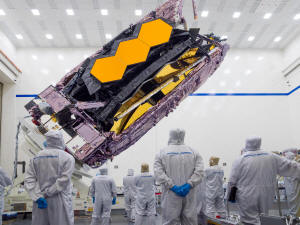NASA begins process of bringing new space telescope into focus
 Send a link to a friend
Send a link to a friend
 [January 13, 2022]
By Steve Gorman [January 13, 2022]
By Steve Gorman
(Reuters) - NASA on Wednesday embarked on a
months-long, painstaking process of bringing its newly launched James
Webb Space Telescope into focus, a task due for completion in time for
the revolutionary eye in the sky to begin peering into the cosmos by
early summer.
Mission control engineers at NASA's Goddard Space Flight Center in
Greenbelt, Maryland, began by sending their initial commands to tiny
motors called actuators that slowly position and fine-tune the
telescope's principal mirror.
Consisting of 18 hexagonal segments of gold-plated beryllium metal, the
primary mirror measures 21 feet 4 inches (6.5 m) in diameter - a much
larger light-collecting surface than Webb's predecessor, the 30-year-old
Hubble Space Telescope.
The 18 segments, which had been folded together to fit inside the cargo
bay of the rocket that carried the telescope to space, were unfurled
with the rest of its structural components during a two-week period
following Webb's launch on Dec. 25.
Those segments must now be detached from fasteners that held them in
place for the launch and then moved forward half an inch from their
original configuration - a 10-day process - before they can be aligned
to form a single, unbroken, light-collecting surface.
The alignment will take an additional three months, Lee Feinberg, the
Webb optical telescope element manager at Goddard, told Reuters by
telephone.

Aligning the primary mirror segments to form one large mirror means each
segment "is aligned to one-five-thousandth the thickness of a human
hair", Feinberg said.
"All of this required us to invent things that had never been done
before," such as the actuators, which were built to move incrementally
at -400 Fahrenheit (-240 Celsius) in the vacuum of space, he added.
[to top of second column]
|

The James Webb Space Telescope is packed up for shipment to its
launch site in Kourou, French Guiana in an undated photograph at
Northrop Grumman's Space Park in Redondo Beach, California.
NASA/Chris Gunn/Handout via REUTERS
 The telescope's smaller, secondary
mirror, designed to direct light collected from the primary lens
into Webb's camera and other instruments, must also be aligned to
operate as part of a cohesive optical system.
If all goes as planned, the telescope should be ready to capture its
first science images in May, which would be processed over about
another month before they can be released to the public, Feinberg
said.
The $9-billion telescope, described by NASA as the premier
space-science observatory of the next decade, will mainly view the
cosmos in the infrared spectrum, allowing it to gaze through clouds
of gas and dust where stars are being born. Hubble has operated
primarily at optical and ultraviolet wavelengths.
Webb is about 100 times more powerful than Hubble, enabling it to
observe objects at greater distances, thus farther back in time,
than Hubble or any other telescope.
Astronomers say this will bring into view a glimpse of the cosmos
never previously seen - dating to just 100 million years after the
Big Bang, the theoretical flashpoint that set in motion the
expansion of the observable universe an estimated 13.8 billion years
ago.
The telescope is an international collaboration led by NASA in
partnership with the European and Canadian space agencies. Northrop
Grumman Corp was the primary contractor.
(Reporting by Steve Gorman; Editing by Karishma Singh)
[© 2022 Thomson Reuters. All rights
reserved.] This material may not be published,
broadcast, rewritten or redistributed.
Thompson Reuters is solely responsible for this content. |